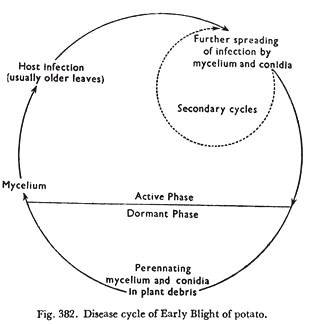In this article we will discuss about the origin of cell wall in plants.
Initially middle lamella creates a new boundary between the two-daughter nuclei of a dividing cell. The components of cell wall deposit on either side of middle lamella to form the cell wall.
In a non-vacuolated cell, nucleus is usually present at the centre where it divides. At telophase, the two nuclei lie at opposite poles. At early telophase, there occurs spindle fibre between the two daughter nuclei. At the equatorial line, these fibres become stronger and form a fibrous spindle termed phragmoplast.
During development, phragmoplast widens out between the two nuclei and becomes barrel shaped. Phragmoplast is the basis for the middle lamella formation and subsequently the cell wall. As the cell plate appears at the middle of phragmoplast, the fibrous spindle disappears. However, the fibrous spindle remains at the margins until the cell plate appears there.
Later researches reveal that phragmoplast is proteinaceous in chemical structure and consists of elements of endoplasmic reticulum, vesicles, microtubules etc. During the formation of cell wall, cytoplasm at the equatorial line and phragmoplast become denser and fibrous termed kinoplasm. Small droplets of fluid particles appear along the median line of phragmoplast.
These particles increase in size, fuse laterally thus forming a fluid plate. The plate first appears at the middle of median line of phragmoplast, gradually extends towards the mother cell wall and finally divides the phragmoplast. The plate is then transformed into middle lamella. The components of cell wall then deposit on both sides of middle lamella to form the cell wall (Fig. 3.8).
 Diagram illustrating cell wall formation in isodiametric (A, B & C) and elongated cells (D, E & F).
Diagram illustrating cell wall formation in isodiametric (A, B & C) and elongated cells (D, E & F).
In a vacuolated cell, nucleus lies towards the cell wall due to the presence of central vacuole. Cell plate originates in the region that was previously occupied by vacuole. The nucleus moves to the centre along the cytoplasmic strands where it divides. The cytoplasmic strands form a plate perpendicular to the plane of nuclear division.
The term phragmosome was coined by Sinnot and Bloch (1941) to designate the cytoplasmic plate. Then in the phragmosome, phragmoplast and cell plate are formed in the usual way that is ultimately transformed to middle lamella.
In the very long cells like fusiform initial of cambium, when division occurs tangentially, phragmoplast initially forms plate between the two daughter nuclei instead of wall to wall. The phragmoplast, which consist of short spindle fibres and dense cytoplasm, becomes barrel shaped and gradually expands towards the cell wall.
The expanding bands, as they approach towards the wall, are broken into arcs – called kinoplasmasomes. The cell plate is formed along the progressing arcs which ultimately divide the cytoplasm completely. In face view, the expanding phragmoplast appears as a circular ring or ‘halo’ surrounding the nuclei. This is termed as phragmosphere, which is merely the circular band of kinoplasmasome.
Later studies reveal that plasma membranes appear first during the formation of two daughter cells after mitosis. At the end of cell division, the membrane- bounded vesicles align themselves at the equator of the mitotic spindle. These vesicles are packed with non-cellulosic polysaccharides.
They fuse at the equator; their membranes become the two plasma membranes and their contents form the middle lamella and matrix of the two daughter cell walls. The daughter cells expand as a result of uptake of water by osmosis.
New wall materials deposited during expansion are from two sources:
(1) The cellulose microfibrils are synthesized at the plasma membrane, and
(2) The matrix polysaccharides, proteins and glycoproteins are formed in the endoplasmic reticulum and Golgi apparatus. Lignin is formed within the cell wall.
Preston suggested that some small ordered granules containing glucan synthetases are present on the outer face of plasmalemma. These granules are (Fig. 3.9) responsible for synthesis and orientation of cellulose microfibrils. The enzyme glucan synthetase is involved in the elongation of microfibrils by addition of glucose residues.
Primary wall material is deposited over the middle lamella during the phase of cell growth. Secondary wall is subsequently laid in some cells once wall extension has ceased.
Later researches with isolated plant protoplast culture indicate that no cell plate is formed; instead, cell wall appears at the outer surface of plasmalemma. Initially an envelope originates surrounding the plasmalemma and then cellulose microfibrils are formed between them. Scan Electron microscopic study reveals that it takes 24 hours or more to form the cell wall of tobacco protoplast.
